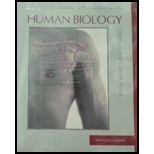
Human Biology: Concepts and Current Issues - With Access (Custom)
15th Edition
ISBN: 9781323045237
Author: Johnson
Publisher: PEARSON
expand_more
expand_more
format_list_bulleted
Concept explainers
Question
Chapter 5, Problem 3AWK
Summary Introduction
To review:
The reason for not recommending the children to learn to throw curveballs at too young age.
Introduction:
Baseball is a popular sport nowadays. This includes activities of various muscles and joints of the body. Curveball is a technique, in which the ball is thrown in such a way that the ball spins forward and dives in a downward direction before reaching the plate. The hand movement requires for the curveball may cause injury.
Expert Solution & Answer
Want to see the full answer?
Check out a sample textbook solution
Students have asked these similar questions
Give only the mode of inheritance consistent with all three pedigrees and only two reasons that support this, nothing more, (it shouldn't take too long)
O
Describe the principle of homeostasis.
Chapter 5 Solutions
Human Biology: Concepts and Current Issues - With Access (Custom)
Ch. 5 - Do you approve of harvesting bone from cadavers...Ch. 5 - What steps do you think should be taken to curb...Ch. 5 - List the five functions of bone.Ch. 5 -
2. Describe the functions of red and yellow bone...Ch. 5 -
3. Explain how the two growth plates in a long...Ch. 5 -
4. Explain what might cause a long bone to slowly...Ch. 5 -
5. Describe the process of bone remodeling and...Ch. 5 -
6. Name the three anatomical regions of the...Ch. 5 - Prob. 7CRCh. 5 -
8. Describe the features of synovial joints that...
Ch. 5 - Prob. 9CRCh. 5 - Prob. 10CRCh. 5 - Which of the following might result from a...Ch. 5 - Steps in the repair of a bone fracture include (1)...Ch. 5 - Prob. 3TYCh. 5 - All of the following bones of the skull are...Ch. 5 - Prob. 5TYCh. 5 - The movement of the thumb to trace a circle might...Ch. 5 - Synovial joints may include cartilage, ligaments,...Ch. 5 -
8. Which of the following is an example of a...Ch. 5 -
9. All of the following are bones of the axial...Ch. 5 - Which of the following would be likely to prevent...Ch. 5 - Which of the following contains the richest...Ch. 5 - In the formation and development of bones within...Ch. 5 - Which of the following might be most helpful in...Ch. 5 - All of the following processes continue in the...Ch. 5 - Which kind of joint is essentially immovable? a....Ch. 5 - Compare and contrast swimming and running as forms...Ch. 5 - Prob. 2AWKCh. 5 - Prob. 3AWKCh. 5 - Prob. 4AWKCh. 5 - Prob. 5AWKCh. 5 - Obesity is a common problem in this country, even...
Knowledge Booster
Learn more about
Need a deep-dive on the concept behind this application? Look no further. Learn more about this topic, biology and related others by exploring similar questions and additional content below.Similar questions
- Explain how the hormones of the glands listed below travel around the body to target organs and tissues : Pituitary gland Hypothalamus Thyroid Parathyroid Adrenal Pineal Pancreas(islets of langerhans) Gonads (testes and ovaries) Placentaarrow_forwardWhat are the functions of the hormones produced in the glands listed below: Pituitary gland Hypothalamus Thyroid Parathyroid Adrenal Pineal Pancreas(islets of langerhans) Gonads (testes and ovaries) Placentaarrow_forwardDescribe the hormones produced in the glands listed below: Pituitary gland Hypothalamus Thyroid Parathyroid Adrenal Pineal Pancreas(islets of langerhans) Gonads (testes and ovaries) Placentaarrow_forward
- Please help me calculate drug dosage from the following information: Patient weight: 35 pounds, so 15.9 kilograms (got this by dividing 35 pounds by 2.2 kilograms) Drug dose: 0.05mg/kg Drug concentration: 2mg/mLarrow_forwardA 25-year-old woman presents to the emergency department with a 2-day history of fever, chills, severe headache, and confusion. She recently returned from a trip to sub-Saharan Africa, where she did not take malaria prophylaxis. On examination, she is febrile (39.8°C/103.6°F) and hypotensive. Laboratory studies reveal hemoglobin of 8.0 g/dL, platelet count of 50,000/μL, and evidence of hemoglobinuria. A peripheral blood smear shows ring forms and banana-shaped gametocytes. Which of the following Plasmodium species is most likely responsible for her severe symptoms? A. Plasmodium vivax B. Plasmodium ovale C. Plasmodium malariae D. Plasmodium falciparumarrow_forwardStandard Concentration (caffeine) mg/L Absorbance Reading 10 0.322 20 0.697 40 1.535 60 2.520 80 3.100arrow_forward
- please draw in the answers, thank youarrow_forwarda. On this first grid, assume that the DNA and RNA templates are read left to right. DNA DNA mRNA codon tRNA anticodon polypeptide _strand strand C с A T G A U G C A TRP b. Now do this AGAIN assuming that the DNA and RNA templates are read right to left. DNA DNA strand strand C mRNA codon tRNA anticodon polypeptide 0 A T G A U G с A TRParrow_forwardplease answer all question below with the following answer choice, thank you!arrow_forward
arrow_back_ios
SEE MORE QUESTIONS
arrow_forward_ios
Recommended textbooks for you
 Human Heredity: Principles and Issues (MindTap Co...BiologyISBN:9781305251052Author:Michael CummingsPublisher:Cengage Learning
Human Heredity: Principles and Issues (MindTap Co...BiologyISBN:9781305251052Author:Michael CummingsPublisher:Cengage Learning Lifetime Physical Fitness & WellnessHealth & NutritionISBN:9781337677509Author:HOEGERPublisher:Cengage
Lifetime Physical Fitness & WellnessHealth & NutritionISBN:9781337677509Author:HOEGERPublisher:Cengage




Human Heredity: Principles and Issues (MindTap Co...
Biology
ISBN:9781305251052
Author:Michael Cummings
Publisher:Cengage Learning


Lifetime Physical Fitness & Wellness
Health & Nutrition
ISBN:9781337677509
Author:HOEGER
Publisher:Cengage